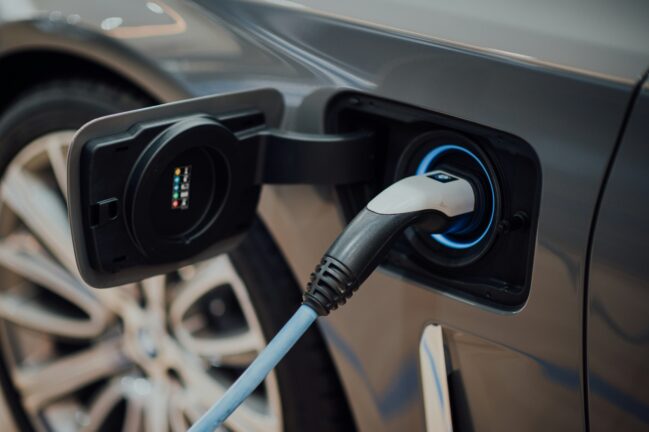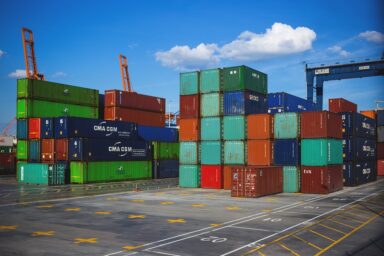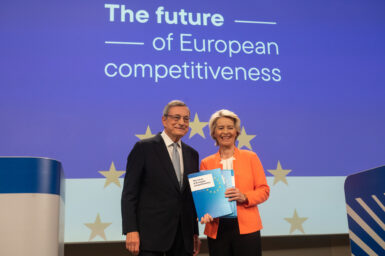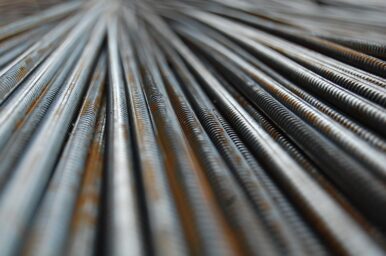European carmakers fret about uncertainty. Overall lack of competitiveness, the impact of burdensome regulation, merciless competition from Asia, and the ambiguous nature of the EU-US trade deal weigh down on the industry, once the beating heart of the continent’s manufacturing and a pillar of its export economy.
The German automotive industry is intensifying its criticism of the US-EU tariff deal, particularly lamenting the ambiguities of the agreement. “The deal between the EU and the USA has not yet brought any clarity or improvement for the German automotive industry,” said Hildegard Müller, president of the Association of the Automotive Industry (VDA). A tariff of 27.5 percent continues to apply to cars and car parts.
This significantly burdens German car manufacturers and suppliers. “It is important that the promised agreement now comes and the reliefs are implemented promptly,” Müller said. For this, the EU Commission and the German government must push hard.
Unpleasant surprise
On 5 August, a Commission official had said he expected the car tariffs to be adjusted “very soon.” The EU had actually assumed, following the framework agreement between US President Donald Trump and EU Commission President Ursula von der Leyen nearly two weeks ago, that the new 15 percent cap on almost all imports would come into effect on 1 August.
In this context, it was particularly expected that the current special tariffs on cars and car parts of 27.5 percent would be lowered to this rate. However, this has not been a topic in the relevant executive order the US President signed last week.
You might be interested
Before the unpleasant surprise, German manufacturers were ready to accept the 15 per cent tariff, a response that mixed relief (from the dreaded 27.5 rate) and pain (reflecting the passing of the years old 2.5 rate). “That global deal for now is it,” Mercedes-Benz chief executive Ola Källenius said, acknowledging that the Trump administration was unlikely to grant any further concessions.
Exaggerated?
Some of his colleagues nurtured hopes for a better deal until the last minute. Volkswagen boss Oliver Blume said he would pursue a separate agreement in order to cut tariffs below 15 per cent by highlighting promises for “huge investments in the US” as late as 30 July.
Not everybody was willing to go that far to appease Mr Trump. “I think this tariff discussion is way exaggerated and also its effects on the industry,” BMW chief executive Oliver Zipse said. “What’s more important is the question, are the products attractive?” Analysts estimate the company would see a hit of up to €1.5bn for the year from EU, US and China tariffs after the carmaker on Thursday disclosed that duties would reduce its five to seven per cent operating profit margin target range for the automotive business by 1.25 percentage points. In the second quarter, the margin stood at 5.5 per cent including a two percentage point impact from tariffs.
Sigrid de Vries, director-general of Acea, the European automobile manufacturers’ association, said the obvious. “Looking forward, the EU and the US should focus on reducing obstacles to vital transatlantic automotive trade, paving the way for stronger economic ties and shared prosperity,“ she said.
Slow, uneven postpandemic recovery
Alas, the tariffs are just one of the numerous issues that Europe’s car industry is struggling to overcome. the sector is now grappling with multiple, overlapping crises: the economic aftershocks of the COVID-19 pandemic, technological upheaval, regulatory pressure, and intensifying global competition.
It is a clear sign of the competitive weakness of our car industry. We all knew years ago that the future of the car was electric, but our industry made the shift reluctantly, and our governments were just as hesitant to shape the right policies. — MEP Gerben-Jan Gerbrandy (Renew/NLD)
The EU automotive industry employs 13.8 million people, representing 6.1 per cent of total EU employment. In countries like Slovakia, Romania, Sweden, the Czech Republic, Hungary, and Germany, the sector accounts for more than 10 per cent of total employment.
The industry began to shake in the wake of the pandemic as supply chains suffered from disruptions. Recovery was slow and uneven, with inflation and soaring energy prices squeezing manufacturers’ margins. A traditionally stable industry has now become volatile. In September 2024, German car giant Volkswagen announced it planned to shut down at least three of its ten factories in Germany, lay off tens of thousands of staff, and cut wages by 10 per cent—despite a 1994 agreement to safeguard these jobs until at least 2029.
Technological change
At the heart of this crisis lies the European industry’s struggle to keep pace with technological change. For decades, companies like Mercedes-Benz and Volkswagen led the global car market with mechanical precision. But the shift to electric vehicles (EVs) requires an entirely new skill set, centered on software, battery technology, and electronic integration.
European firms have been slow to adapt. Rivals, particularly Chinese brands like BYD, surged ahead, supported by strong industrial policies. With European brands remain hesitant to fully commit to EVs, it is Chinese manufacturers who is setting the pace.
Meanwhile, strict EU climate regulations have added another layer of challenge. In 2020, the EU tightened its CO₂ emissions targets for cars, requiring manufacturers to reduce average emissions from new vehicles by 15 per cent by 2025, 55 per cent by 2030, and 100 per cent by 2035 (compared to 2021 levels), effectively mandating a phase-out of combustion engines.
Regulation and competition
Manufacturers raised concerns, arguing the targets were too aggressive in the light of the current state of the market and infrastructure. Bowing to pressure, the European Parliament, with reluctant support from groups like S&D and Renew, agreed earlier this year to delay the financial penalties for non-compliant manufacturers by three years. These will now begin in 2029 instead of 2026, giving carmakers more time to adjust without officially changing the 2035 phase-out deadline.
At the same time, competitive pressure continues to mount. Chinese brands are rapidly gaining ground. According to the EU, part of this success is due to effective state subsidies that allow Chinese manufacturers to undercut European prices.
Instead of easing the regulatory burden and tackling soaring production costs, it adds layer upon layer of bureaucracy while maintaining rigid climate targets that disadvantage European manufacturers. — MEP Daniel Obajtek (ECR/POL)
In response, Brussels launched an anti-subsidy investigation in October 2023, concluding that major producers such as BYD, SAIC, and Geely benefited from unfair support from the Chinese government. The European Commission subsequently imposed provisional import duties ranging from 17.4 per cent to 38.1 per cent on electric vehicles made in China. (To limited effect; in the first half of 2025, Chinese carmakers captured 5.1 per cent of the European car market, nearly matching Mercedes-Benz’s 5.2 per cent market share.)
Raw materials export ban
In addition to pricing pressure, Europe now faces an acute supply chain vulnerability. In April 2025, China imposed a ban on six rare earth elements crucial for magnets used in EVs and hybrid vehicles.
The impact has hit the automotive sector hard. Rare earth magnets feature in everything from electric motors to basic components like windshield wipers, power windows, steering systems, and brakes. According to the European Association of Automotive Suppliers (CLEPA), April’s export restrictions forced several factories to halt operations. Suzuki Motors, for example, temporarily suspended production of its Swift models in Hungary.
All in all, Brussels realized action was long overdue. In March 2025, the European Commission unveiled its a €1.8bn Industrial Action Plan for the Automotive Sector, aiming to reconcile the continent’s climate ambitions with the growing economic pressure on carmakers and their workers.
A mixed response to the rescue plan
The plan promised investments in battery production, critical raw material supply, and autonomous vehicle innovation. It also formalized the three-year delay in CO₂ penalties mentioned earlier.
“I want to see our European automotive industry taking the lead,” said Commission President Ursula von der Leyen. “We will promote domestic production to avoid strategic dependencies, especially for battery manufacturing.”
Yet the plan was met with mixed reactions, and in many quarters, disappointment. The Left group in the European Parliament called it “a corporate subsidy plan that offers little to workers”. MEP Daniel Obajtek (ECR/POL), a member of the Parliament’s Industry Committee, said: “The Commission’s Action Plan is full of grand visions but lacks the practical measures needed to ensure Europe’s competitiveness. Instead of easing the regulatory burden and tackling soaring production costs, it adds layer upon layer of bureaucracy while maintaining rigid climate targets that disadvantage European manufacturers.”
Just like Nokia, it’s the lack of innovation that threatens our future, not the goals we’ve set eight years ago. — MEP Mohammed Chahim (S&D/NLD)
Acea cautiously welcomed what it called the plan’s “pragmatic turn,” but insisted the CO₂ relaxation didn’t go far enough. According to them, the Commission still failed to commit to reviewing broader emissions standards by 2025. Germany’s industry federation BDI echoed that sentiment, calling the concessions insufficient.
A deeper problem?
Behind the technical arguments, a deeper unease has surfaced in Brussels. Many believe the EU is buying time with quick fixes rather than confronting the structural shifts reshaping the global car industry. In this spirit, advocacy group Transport & Environment criticized the weakening of CO₂ targets as a de facto denial of a new reality, one shaped by software, data ecosystems, and scale, in whcih where Chinese brands excel. The group argued the concessions to carmakers should be the last. In their view, the plan contains only vague commitments to support battery manufacturing, leaving Europe at risk of falling even further behind China.
Some parliamentarians echoed that view in stark terms. During the debate on CO₂ emission reductions, MEP Gerben-Jan Gerbrandy (Renew/NLD) said: “It is a clear sign of the competitive weakness of our car industry. We all knew years ago that the future of the car was electric, but our industry made the shift reluctantly, and our governments were just as hesitant to shape the right policies. With all the money now being used to bail them out, the industry could have long since invested in its own transformation.”
MEP Mohammed Chahim (S&D/NLD) drew a comparison to Nokia, the Finnish one-time leader of the mobile phone market. “Just like Nokia, it’s the lack of innovation that threatens our future, not the goals we’ve set eight years ago,” the MEP said.









